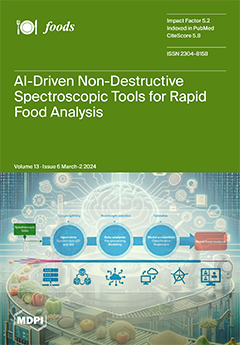In an animal production system, different stressors may cause the depletion of muscle glycogen stores, resulting in an elevated pH at 24 h
post mortem (pH
24), which leads to cell metabolism alterations that affect the conversion of muscle into meat, causing
[...] Read more.
In an animal production system, different stressors may cause the depletion of muscle glycogen stores, resulting in an elevated pH at 24 h
post mortem (pH
24), which leads to cell metabolism alterations that affect the conversion of muscle into meat, causing meat quality defects, such as dark-cutting beef, also known as dark, firm, and dry (DFD) beef. This process may involve the alteration of small non-coding RNAs (miRNAs), which play critical regulatory roles in cellular processes. Here, we determined whether differential miRNA expression in the
Longissimus thoracis et lumborum muscle from the Asturiana de los Valles breed at 24 h
post mortem could serve as an early indicator of beef quality defects. Following total RNA extraction, complete miRNAome sequencing revealed 12 miRNAs that were significantly upregulated (
p < 0.001) in DFD beef compared to the levels in CONTROL beef. These miRNAs are mainly involved in the cellular responses to redox imbalances and apoptosis. Among these, four miRNAs known to be related to oxidative stress (
bta-miR-1246,
bta-miR-2332,
bta-miR-23b-5p, and
bta-miR-2411-3p) were validated via quantitative RT-PCR. Some of their target proteins were also analyzed using Western blotting. High 70 kDa heat shock protein and low Caspase-9 expressions (
p < 0.01) were found in DFD beef, suggesting the downregulation of apoptosis. These results suggest the importance of miRNAs in regulating stress in muscle cells during early
post mortem, as differences in the abundance of some of these miRNAs are still observed at 24 h
post mortem. These changes lead to an inadequate conversion of muscle into meat, resulting in meats with quality defects.
Full article






